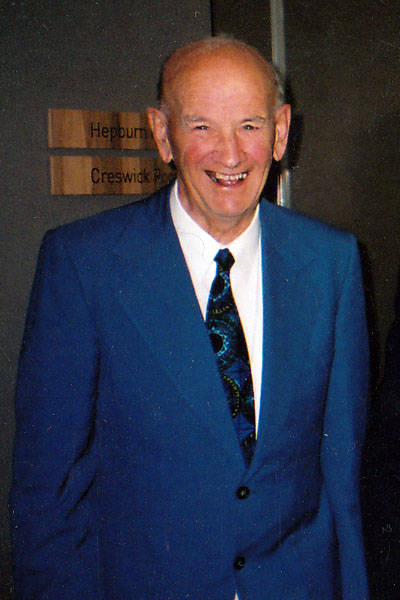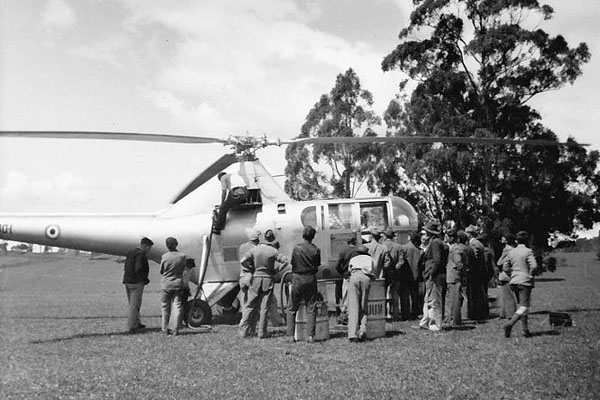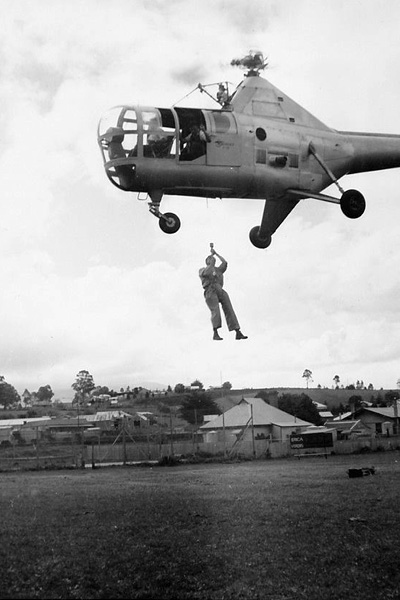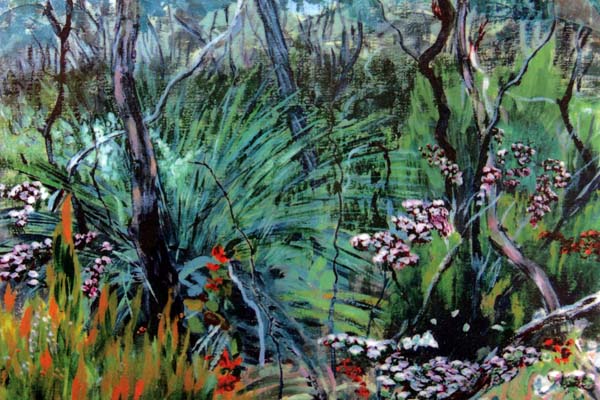Duke William Murray Paine
Forest Assessor
Murray went to the VSF from Birchip in 1941 as a 16 year old, and graduated from the University of Melbourne in 1946 with a BSC (Forestry). He went on to have a most influential career in both the FCV and CFL before retiring from the public sector in 1985. In 2000 he completed a story about his life entitled "A Good Run in the Perfect Job", and his sons, Bruce, David and Mark have given permission for the FCRPA to use extracts from that publication on this site.
Perhaps Murray was best known for his major contribution to the understanding of Victoria's timber resources because of his time as Forest Assessor for the FCV from 1953 until the early 1970s. Field assessment most often involved new VSF graduates, and many would remember Murray for his strong mentoring role during this time. However, as his story shows, his career path had other elements that we need to explore.
Below are some extracts about particular subjects that are covered in Murray's story, and his complete account on each subject is available via the link attached to each heading.
Aircraft - (Full Extract)
We heard great news from Canada that after the war their Air Force had developed methods of dropping water from aircraft on the burning edges of forest fires. That sounded like a good idea to us, and the Australian Air Force thought it sounded like an appropriate post-war activity, so there were some consultations and preparations for a test of water-bombing. I arrived in time for the first demonstration test in the bush, on an open heathy hillside where we all could see the action. The water bomb was an oil drum of about ten gallons. The plane arrived and flew a dummy run to verify its target and then came in low and dropped the water bomb. In an instant the drum was flattened by the impact on the ground, the water was spread in a thin sheet, and the flattened drum went spinning like a discus straight over the heads of the officers standing on the crest of the hill.
The Air Force took delivery of five beautiful new Sikorsky helicopters, and they wanted action, useful domestic action. These powerful machines could hover at about twenty feet above the ground, and they could raise and lower people on a winch. How about that for delivering men and equipment to fight fires in remote locations?
'Good' we said; and we set off to east Gippsland to show our firefighters how it was done. We began out in the open, in the middle of a football ground where there were no trees, and no smoke either, and I was first volunteer to be hoisted up on the winch to the cabin while the motor roared and the blades slashed around overhead, and then I was lowered again to the ground.
Come to think of it, maybe I was the only volunteer.
Bushfires - (Full Extract)
The enormous catastrophic bushfires of January 1939 occurred when I was at home in Birchip on school holidays. The news was horrific; but we in Birchip didn't have any grassfires or see any smoke. We had extremely hot weather with dust storms from the north every few days. The fires were a shattering tragedy for the people of Victoria, and they left the timber industry and the forestry profession in chaos.
We began our training at the forestry school just two years after the catastrophe, and we found that almost every statement about the department and the industry was prefaced by 'before 1939' or 'since 1939' and everyone was quite toey.
My summer vacation work the next year showed me what had happened to the precious mountain forest. There were thousands and thousands of standing dead trees with their bare branches reaching upwards, on every mountainside that I could see. Beneath them was a crop of millions of tree seedlings of ash, and wattles and all the other undergrowth shrubs, a miracle of regeneration. To the department and the timber industry it all represented a mass of timber that had to be salvaged in great haste, the logs stacked in heaps, their ends coated with wax to retard splitting, and sprayed with water until they could be used.
Being a forester was a pretty rough game. My boss at Mansfield would squeeze his eyes tight every few moments as he was speaking to us, because of smoke injury in 1939. He had to crawl into a culvert pipe to save his life when fighting fires in the Grampians.
It was probably the attraction of a chance to go into fire weather forecasting that led me to leave assessment after a couple of years and go into fire protection..... I made small wooden rafts of pine and we exposed them in the bush and weighed them daily to get an indication of the dryness of the branchwood, bark and other litter on the ground, and hence of how inflammable it was. That information, taken together with the weather forecast, was the basis of our estimate of the fire danger from day to day as the summer progressed. I took the weather forecasts each day and interpreted them as fire danger forecasts, and that led me to the new ideas in meteorology that had arrived in a book by Norwegian meteorologists, about air masses, their properties and movements, and how fronts developed between them.
I helped in the development of a few items of equipment; and persuaded our group to forget about the new fad of putting wetting agents in the water in tankers. We purchased ex-army telescopes and installed them on compass bases in fire lookout towers. I devised several displays to publicise the fire protection message; sorted out the tangle between the 1940 forest fire laws and the 1945 country fire legislation, and explained it in a poster for the district offices. For a while I was chief of the whole show when others, including the big chief, moved elsewhere.
VSF - (Full Extract)
Among the instructions for my start in the forestry school there was the surprising requirement to bring riding leggings and jodhpurs (the school uniform) and an oil skin coat and rubber wellington boots. That sounded different from life in the Mallee, and so it was; we had to do practical work every afternoon in Creswick's highland weather.
On cold wintry days, a speciality of Creswick, we would don trousers, boots and stuff, still half wet from the previous day, and walk across to the forest nursery nearby in Sawpit Gully. There we were instructed and employed by a team of funny old blokes in the arts of forest nursery practice, potting, weeding, wrenching, transplanting and lifting; and then out in the planting areas, of pitting and planting.
When winter had really set in and the ground was sodden it was time to lift the 'one-one' pines that were standing in their rows and plant them out on the hills. Their roots had been shortened by undercutting them with spades (wrenching), and they were tall and strong. This was when we needed our oilskins and rubber boots. We walked out to the planting area, which was littered with bits of charcoal, ashes, and partly burnt branch wood, and there we dug pits, one spade wide each way and one spade deep, break the clods, and step forward eight feet to the next one. Later on we carried bundles of 100 plants each to the rows, filled one side of a pit with soil (clay!) then the pine, more soil, tread it down well, and wish him all the best. That was how the miles and miles of pines had been established for many years before we appeared.
We built an enclosure for koalas, to be the Creswick Koala Park, a sanctuary for surplus stock from Phillip Island. We cleared a line for the fence, cut fence posts, fitted cross arms to them and strung wire and netting along.

Murray Paine
2010
Source: R Smith

RAAF Sikorsky at Erica
1949
Source:FCRPA

RAAF Sikorsky at Erica
1949
Murray Paine on the winch line?
Source:FCRPA
The firewood bush was managed under a time-honoured system of silviculture called coppice with standards, subject of classroom lectures in second year, and of long history in England and in India. The common woods and forest estates in England were managed that way for centuries. The standards were fine big mature trees with straight trunks reserved from cutting until the owner or manager decided he could spare a few for sale as prime logs for sawing or heavy constructions. The coppice grew as sprouts from the stumps and it was cut when quite small for fuel and small farm poles. What worked for oaks and elms in England, and teak in India, was adapted to messmates and peppermints in Victoria.
Assessing- (Full Extract)
Sometime in 1961 I noticed that IBM was offering free 5-day courses in programming for their computer, the IBM650, and I went to find out what that was all about..... So I learned Fortran and set about writing programs for calculating our timber estimates from sample data that we had recorded in the bush and pine plantations. Not long before this I had been in raptures at having acquired an electric Monroe calculator!
Our winter assessment work in those days was to survey our sample lines across blocks of the Wombat Forest, a big slab of second-growth messmate and peppermint between Ballarat and Macedon, and when we were nearing the end of that work I asked two young foresters to set out about thirty small plots with 10 to 12 trees on each and to find out how rapidly they were growing by cutting into them with very sharp axes and measuring the width of the growth rings in about an inch of the new wood. This gave us our first estimate ever of the rate of the growth of useable timber of a whole forest.
The next year we surveyed a new set of plots, marked their locations secretly and set pegs in the ground to enable us to find them in future. We measured each tree's girth near the butt, and its useable length, and recorded branches and swellings on the trunks. This was to be our Continuous Forest Inventory, and sure enough we were able to go back a few years later and find all our secret plots (hidden so they would not receive biased treatment when harvesting operations went through them), remeasured the trees and noted any that had died or fallen, any that had shed branches and thus increased their useable lengths, and noted any that had attained useable size.
We used some new names (mortality, increment, ingrowth, drain) and adopted a routine for grading the logs by quality, a practice that was politically incorrect in the department and the industry at the time; and then we had a new estimate of growth of the Wombat forest, and how much of the growth was contributed by its various components, tree sizes and species.
I had accepted the belief that the fundamental role of the professional forest manager was to develop a rational basis for deciding the rate of annual harvest from the forest; and our Continuous Forest Inventory had enabled me to do that, for a regrowing forest of native species - it was a rare privilege.
Having a detailed estimate of the growth rates of trees of all girth sizes, heights and species in a forest enabled us to do a little mathematical exercise called linear programming which showed us which categories of trees should be harvested to yield a set volume of logs and keep the forest growing at the best rate. That was too much for the field foresters to take, especially as it ran against their instinct which would have them retaining those beautiful big 'fast-growing' dominant trees that they had been admiring all this time.
Our study plots gave us a list of allowances to make for the indicators of defect; swellings meant advanced decay, fire scars meant decay with termites, and so on. We had started in a tough place. The east Gippsland bush with its big old silvertop trees had been burnt time and again, their thick tough bark (very similar to iron bark) had saved their lives and they had kept on growing, and the fungi and termites had spread through the wood with ease, making it more difficult to assess the defect than in most other forests.
Mansfield 1951-1953 (Full Extract)
I continued in fire protection for one year after we were married, and then we went to Mansfield where I was to be one of two assistants to the district forester, and thus gain 'district experience', the absolutely essential qualification for promotion in the department.
The backyard sawmills on the small bush farms were a nuisance. They were supplying the housing industry, and that annoyed the established sawmillers; they were probably poaching logs from the forest to supplement their own supplies; and they constituted a fire risk that was unbearable to the older foresters and sawmillers who remembered that bush sawmills had started the terrible fires of 1939.
I went and fought several fires each summer that we were there. The fires usually occurred in mid-afternoon; our local crews would tackle them immediately and, if needed, we would get to them in an hour or two, and then work on them till late at night - ad exhaustion. There was an element of urgency and adventure in the task for us, but the older workmen hated it. They'd seen it all before, fought fires for days on end without stopping them, and been expected to turn out and heroically save the forest again next week, or next weekend, which was worse still. No-one saw or knew what they had done, nor thanked them.
Eventually the conditions of employment on firefighting for the workmen and ourselves were improved, with proper overtime payments and regular rest periods. Most astonishing was that we permanent officers received overtime payments for firefighting. It was my first cheque for fire-fighting overtime that bought us a washing machine.
Horses - Yes, that's right - Horses (Full Extract)
I wheeled my horse around and headed him off; then he started around through the bush another way to get to the track, and I headed him again; it was getting to be like a Tom Mix movie as the pace got quicker, wheeling and racing among the trees. He beat me to the track and was off toward the farm at a good pace; if I lost him now I'd have to go all the way back to the farm, so I gave him a run for it, head to head along the track. I drew level with him, leant over and grasped the rope hanging from his halter; 'Got 'im!'.
I didn't have to decide what to do next. Somehow, quite suddenly, I was on my back on the road with a bump, a rope in one hand and reins in the other, and the two horses were standing stock still, one at each side of me, awaiting further orders. We regrouped and proceeded up the track towards the camp, and work.
Our task was merely to get supplies up to the top camp every few days; and our cook made special efforts to prepare good stuff for them, like nice roasts and apple pies. They had to have wheaties and bread, and, of all things, foul-smelling, always-leaking, infinitely-penetrating kerosene (paraffin). We loaded the provisions in the pack bags, and placed them ready to be lifted and hooked to the packsaddle.
Refresher Courses - (Full Extract)
I was instructed to run some five-day residential courses called forestry refresher courses for district foresters and their peers in specialist positions at their old school at Creswick. The head of the department and his colleagues expected instructional courses on challenging new ideas in forest science; while I was planning a week's work in which the guys decided for themselves what their main concerns were and what aspects of them they needed to explore. I had a short sharp scrap about this with him when I revealed my intentions at the very last minute before the course began - 'But what are you going to teach them?' 'We want them to take more responsibility; so I'm going to make them make decisions.' - and off I went to Creswick to launch the first course.
Stories and Reflections - (Full Extract)
I seem to have been a link between the theoretical areas of our profession and the practical field operators. I was attracted to the mathematical mode of thinking and advancing our knowledge, and always dissatisfied because my own maths was inadequate, but I had to talk non-maths to my colleagues.
I treasure the opportunity I had to develop my work in my own way, concentrating on the lines that I valued most; and realised just how fortunate I was to be able to apply the ideas that appealed to me during my forestry education.
I loved the deep dense bush so much that I was content just to be in it, walking about or simply standing and looking, and when the work took me back to the Mallee and the deserts I was at home again there too. I really did have a good run in the perfect job.
People's work was a great interest, from the time the man forming up the Duncan Street roadway in Birchip told me how he was paid a skill margin for being expert in spreading gravel with his shovel, to the time I suggested to the Benalla people that they should meet and talk about their work.
Perhaps it came from deeper than that. I was the sole defender of the forest overseers and foremen when there was a move to exclude them from the foresters' association; and I initiated and conducted a project that made small study grants to some of them to enable them to travel and see how their kind of work was being done in other forests.
Writing here about my work has led me to associate these things for the first time. Perhaps I respected the knowledge of the man in the bush as much as I valued the various technical and managerial innovations I came across.
See also:
FCV Bulletin 18
The Missing Forest
Mallee Origins "A long paper (at a Mildura symposium) about the origins of the Malleee impressed me so much I wrote my own paper in order to understand it." DWMP- July 2008.
A gallery of his paintings

Little Desert Myrtle
A painting by Murray Paine
